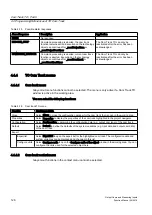
4. Before you determine the hardware address, an alignment between HW Config and
SIMOTION SCOUT, with respect to the address, must be performed. If this has not been
performed or you have changed the addresses, click on Set up addresses. If there are
question marks in the fields instead of I/O addresses, you must also perform an alignment.
5. Now calculate the hardware address by adding the base output address (first value of the
output data) of the Control Unit to the offset (for example, 256 + 3 = 259). The offset always
has the value 3.
6. You will find the bit number in the following table.
Table 4-13
Bit numbers for D410 and D4x5
Output D4x5
Output D410
Bit number
X122.7 (DI/DO 8)
X121.7 (DI/DO 8)
Bit 0
X122.8 (DI/DO 9)
X121.8 (DI/DO 9)
Bit 1
X122.10 (DI/DO 10)
X121.10 (DI/DO 10)
Bit 2
X122.11 (DI/DO 11)
X121.11 (DI/DO 11)
Bit 3
X132.7 (DI/DO 12)
-
Bit 4
X132.8 (DI/DO 13)
-
Bit 5
X132.10 (DI/DO 14)
-
Bit 6
X132.11 (DI/DO 15)
-
Bit 7
Note
In the case of versions earlier than V4.2, when using 39x telegrams, the onboard D4x5
outputs are to be assigned exclusively to SIMOTION. During a consistency check in
SIMOTION SCOUT, no check is made as to whether the entered HW address actually
belongs to a high-speed digital output (DO).
4.3.7
Configuring cam track on the SIMOTION D410-2
1. In the project navigator, switch to the Control Unit via SINAMICS_Integrated >
Control_Unit.
2. Double-click Inputs/outputs below the control unit. The window appears on the workspace.
3. Switch to the Bidirectional digital inputs/outputs tab.
Cam Track TO - Part II
4.3 Configuring the TO Cam Track
Output Cams and Measuring Inputs
Function Manual, 04/2014
111
















































